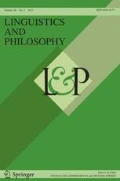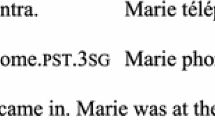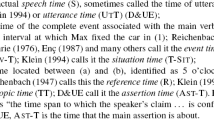Abstract
This paper investigates the semantics of tense and aspect in Romance languages. Its goal is to develop a compositional, model-theoretic semantics for tense and temporal adverbs which is sensitive to aspectual distinctions. I will consider durative adverbial distributions and aspectual contrasts across different morphological tense forms. I will examine tense selection under habitual meanings, generic meanings and state of result constructions. In order to account for these facts I will argue that temporal homogeneity plays a fundamental role in tense selection in Romance languages.
Similar content being viewed by others
References
Abusch D. (1994) Sequence of tense revisited: Two semantic accounts of tense in intensional contexts. In: Kamp H. (eds) Ellipsis, tense and questions Stuttgart, Dyana-2 Esprit Basic Research Project 6852.. University of Amsterdam, Amsterdam
Abusch D. (1997) Sequence of tense and temporal de re. Linguistics and Philosophy 20(1): 1–50
Bennett M., Partee B. (1972) Toward the logic of tense and aspect in English. Santa Monica, CA, System Development Corporation
Bertinetto P.M. (1986) Tempo, aspetto e azione nel verbo italiano: Il sistema dell’indicativo. Presso l’Accademia della Crusca, Firenze
Bertinetto P.M. (1991) Il verbo. In: Renzi L., Salvi G. (eds) Grande grammatica italiana di consultazione. (Vol. II,). Bologna, Il mulino, pp 13–162
Bertinetto P.M. (2001) On a frequent misunderstanding in the temporal-aspectual domain: the «perfective- telic» confusion. In: Cecchetto C., Guasti T., Chierchia G. (eds) Semantic interfaces.. Stanford, CSLI, pp 177–210
Bonomi, A. (1995). Aspect and quantification. In P. M. Bertinetto, V. Bianchi, J. Higginbotham, & M. Squartini (Eds.), Temporal reference, aspect, and actionality. (Vol. I, pp. 309–324). Torino, Rosenberg and Sellier.
Bonomi A. (1997) Aspect, quantification and when-clauses in Italian. Linguistics and Philosophy 20: 469–541
Bonomi, A. (1998). Semantical remarks on the progressive readings of the imperfective. Paper presented at the conference On Syntax and semantics of tense and mood selection, Bergamo, 2–4 July.
Comrie B. (1976) Aspect: An introduction to the study of verbal aspect and related problems. Cambridge University Press, Cambridge
Davidson, D. (1967). The logical form of action sentences. In N. Rescher, (Ed.), The logic of Decision and action. (pp. 81–95). Pittsburgh: University of Pittsburgh Press. (Reprinted by D. Davidson, Ed., (1990, Essays on actions and events, pp. 105–122). Oxford: Clarendon Press.
de Swart H. (1998) Aspect, shift and coercion. Natural Language and Linguistic Theory 16: 347–385
Dowty D. (1979) Word meaning and montague grammar. D. Reidel, Dordrecht
Galton A. (1984) The logic of aspect: An axiomatic approach. Clarendon Press, Oxford
Heim I. (1994) Comments on Abusch’s theory of tense. Ms, MIT, Cambridge, MA
Heim I., Kratzer A. (1998) Semantics in generative grammar. Blackwell, Oxford
Herweg M. (1991) Perfective and imperfective aspect and the theory of events and states. Linguistics 29: 969–1010
Higginbotham J. (1985) On semantics. Linguistic Inquiry 16: 547–593
Hinrichs, E. (1985). A compositional semantics for Aktionsarten and NP reference in English. PhD dissertation, Ohio State University.
Hornstein N. (1990) As time goes by: Tense and universal grammar. MIT Press, Cambridge, MA
Katz, G. (1995). Stativity, genericity, and temporal reference. PhD Dissertation, University of Rochester
Katz G. (2000) Anti neo-Davidsonianism: against a Davidsonian semantics for state sentences. In: Tenny C., Pustejovsky J. (eds) Events as grammatical objects. CSLI Publications, Stanford CA
Klein W. (1994) Time in language. London and New York, Routledge
Kratzer, A. (1998). More structural analogies between pronouns and tenses. In D. Strolovitch & A. Lawson (Eds.), SALT 8, Cambridge, MA, Ithaca, CLC-Publications.
Kratzer, A. (2000). Building statives. Berkeley: University of Massachusetts at Amherst, Berkeley Linguistic Society.
Krifka, M. (1986). Nominalreferenz und Zeitkonstitution. Zur Semantik von Massentermen, Individualtermen, Aspektklassen. PhD dissertation, The University of Munich.
Krifka M. (1990) Four thousand ships passed through the lock: Object-induced measure functions on events. Linguistics and Philosophy 13: 487–520
Krifka M. (1992) Thematic relations as links between nominal reference and temporal constitution. In: Sag I., Szabolcsi A. (eds) Lexical matters.. CSLI Publications, Chicago University Press, Chicago, pp 29–53
Lenci, A., & Bertinetto, P. M. (2000). Aspects, adverbs and events: Habituality vs. perfectivity. In A. F. P. Varzi, (Ed.), Facts and events. Oxford: Oxford University Press.
Löbner S. (1988) Ansätze zu einer integralen semantischen Theorie von Tempus, Aspekt und Aktionsarten. In: Ehrich V., Vater H. (eds) Temporalsemantik Beiträge zur Linguistik der Zeitreferenz.. Tübingen, Niemeyer, pp 163–191
McCoard R.W. (1978) The English perfect: Tense choice and pragmatic inferences. North-Holland, Amsterdam
Musan R. (2000) The semantics of perfect constructions and temporal adverbials in German. Humboldt Universität, Berlin
Musan R. (2003) Seit-adverbials and perfect constructions. In: Alexiadou A., Rathert M., von Stechow A. (eds) Perfect Explorations.. Mouton de Gruyter, Berlin, pp 253–276
Oldsjö F. (2001) Tense and aspect in Caesar’s narrative. Uppsala, Uppsala Universitet
Parsons T. (1990) Events in the semantics of English. A study in subatomic semantics. MIT Press, Cambridge MA
Piñón C. (1999) Durative adverbials for result states. In 18th West coast conference on Formal linguistics. Cascadilla Press, Somerville
Prior A. (1957) Time and modality. Claredon Press, Oxford
Scheiner M. (2002). Temporale Verankerung habitualler Sätze. MA Thesis, Universität Wien. Wien.
Thomason R.H., Stalnaker R. (1973) A semantic theory of adverbs. Linguistic Inquiry 4: 195–220
von Stechow, A. (2000). How are results represented and modified? Remarks on Jäger & Blutner’s antidecomposition. In C. Fabricius-Hansen, E. Lang, & C. Maienborn (Eds.), Adverbs: Proceedings of the Oslo conference on Adverbs, 26–28. October 1999.
von Stechow A. (2002) German seit “since” and the ambiguity of the German Perfect”. In: Ingrid K., Barbara S. (eds) More than words: A Festschrift for Dieter Wunderlich (vol. 53).. Akademie Verlag, Berlin, pp 393–432
von Stechow A., Paslawska A. (2000) Deriving perfect readings in Russian/Ukainian. Ms, Thessaloniki
Author information
Authors and Affiliations
Corresponding author
Rights and permissions
About this article
Cite this article
Arosio, F. Infectum and Perfectum. Two faces of tense selection in Romance languages. Linguist and Philos 33, 171–214 (2010). https://doi.org/10.1007/s10988-010-9078-x
Published:
Issue Date:
DOI: https://doi.org/10.1007/s10988-010-9078-x




